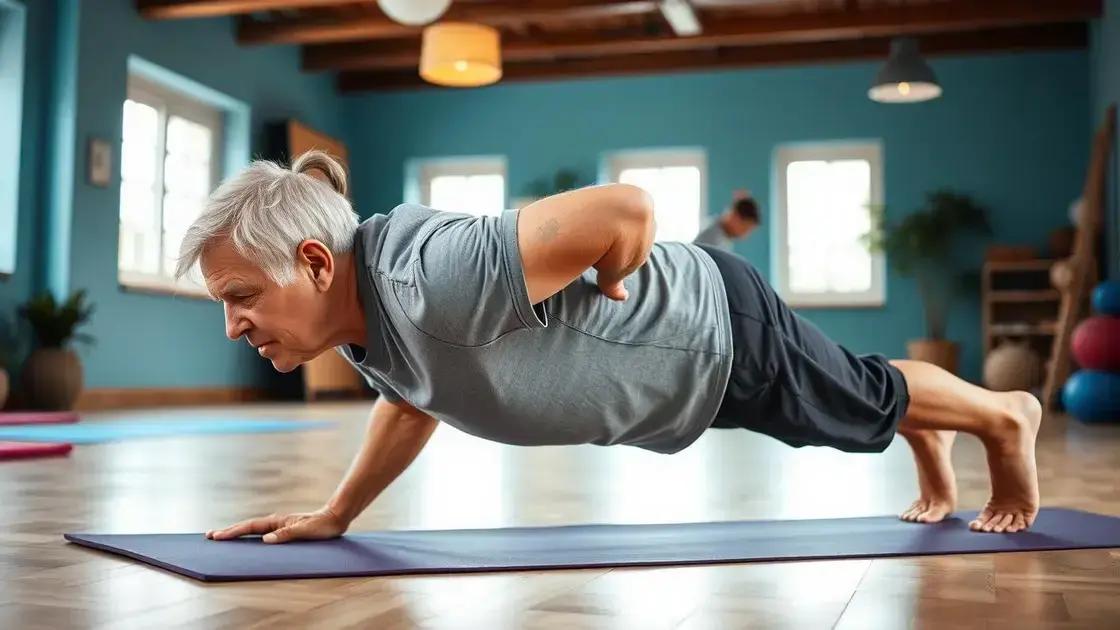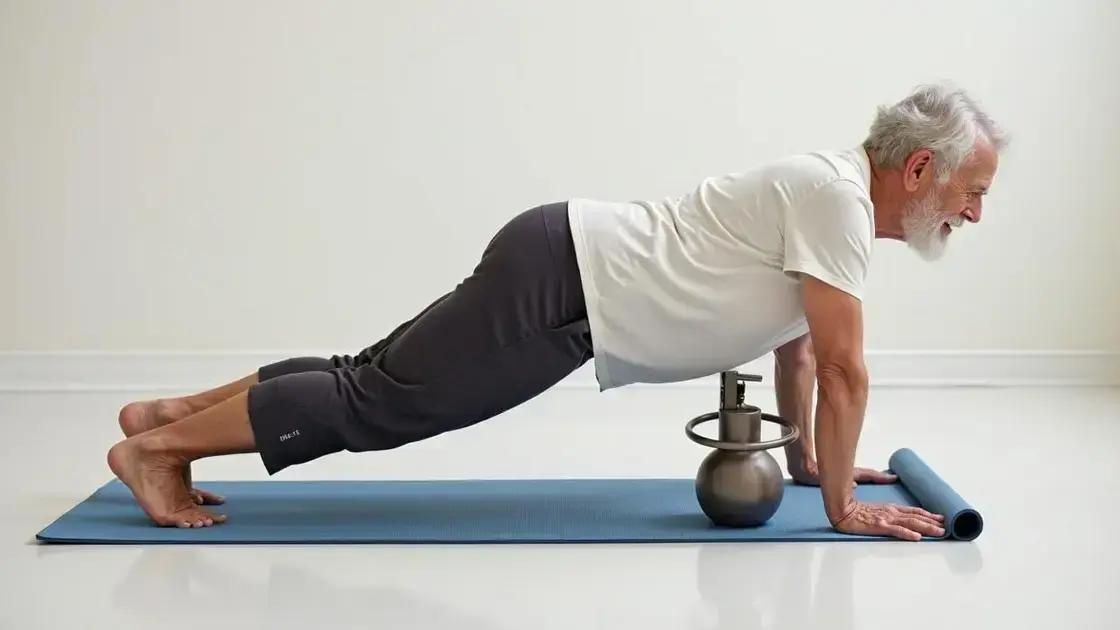This article explores how to perform push-up variations safely after 50, highlighting the benefits of push-ups, safe techniques, common mistakes to avoid, and how to adapt them to your fitness level for improved strength and health.
As we age, maintaining strength and flexibility becomes crucial for overall health. Push-ups are an excellent exercise for seniors, promoting upper body strength while improving cardiovascular health. In this post, we’ll explore how to perform push-up variations safely after 50, ensuring you reap the benefits without risking injury.
The Benefits of Push-Ups After 50

Push-ups have numerous benefits for individuals over 50, contributing significantly to strength, flexibility, and overall health.
Improves Upper Body Strength
As we age, muscle mass naturally declines. Push-ups help combat this by strengthening the major muscle groups in the upper body, including the chest, shoulders, and triceps. This increased strength is essential for performing daily tasks.
Enhances Core Stability
Push-ups are not just an upper body exercise; they also engage the core muscles. Maintaining a strong core is vital for balance and reduces the risk of falls, which can be particularly dangerous for seniors.
Boosts Bone Health
Weight-bearing exercises like push-ups contribute to bone density. Maintaining strong bones is crucial for preventing osteoporosis and fractures, especially for individuals 50 and older.
Promotes Heart Health
Regularly performing push-ups can boost cardiovascular health. This exercise elevates your heart rate, improving circulation and supporting heart health, which becomes increasingly important with age.
Encourages Joint Health
Strengthening muscles around the joints through push-ups can also help alleviate joint pain. Healthy muscles provide better support, reducing stiffness and improving mobility.
Accessible and Versatile
Push-ups can be modified to suit any fitness level. Whether using a wall, bench, or the ground, there’s a variation for everyone. This accessibility makes them an excellent choice for those over 50.
Safe Push-Up Techniques for Older Adults

Safe push-up techniques are essential for older adults to perform this exercise without risking injury.
Start with Wall Push-Ups
For beginners, wall push-ups are a great starting point. Stand a few feet away from a wall, place your hands on the wall, and lower your body toward it. This reduces the weight on your arms and makes it easier on the joints.
Use Modified Push-Up Positions
Modified push-ups, such as knee push-ups, can help reduce strain. Begin on your knees instead of your toes, and maintain a straight line from your head to your knees. This position is safer for those with limited upper body strength.
Maintain Proper Form
To prevent injuries, focus on keeping your body aligned. Your hands should be shoulder-width apart, and your back should remain straight. Avoid letting your hips sag or your head drop.
Practice Controlled Movements
Perform push-ups slowly and in a controlled manner to avoid sudden movements that could lead to injury. Lower yourself gently, and push back up with a steady pace.
Listen to Your Body
Pay attention to your body’s signals. If you feel pain or discomfort during a push-up, stop immediately and assess your form or modify the exercise further.
Consider Using Push-Up Bars
Using push-up bars can enhance stability and reduce strain on the wrists. These bars allow for a greater range of motion and can make it easier to keep your wrists in a neutral position.
Common Mistakes to Avoid

Avoiding common mistakes is essential for older adults performing push-ups to ensure safety and effectiveness.
Neglecting Warm-Up
Skipping a warm-up can lead to injuries. Always perform stretches and light exercises before starting your push-ups. Warming up increases blood flow to the muscles and prepares the body for physical activity.
Using Incorrect Form
One of the most significant mistakes is not maintaining proper form. A straight body line is crucial during push-ups. Ensure your head, back, and heels are aligned to avoid undue stress on your spine.
Overdoing It
Trying to do too many push-ups can lead to fatigue and injury. Start slowly and gradually increase your repetitions as your strength builds. Listen to your body and rest when needed.
Rushing the Movements
Performing push-ups too quickly can compromise stability and control. Focus on slow and controlled movements to maximize benefits and reduce the risk of sprains or strains.
Ignoring Pain Signals
If you experience pain, stop immediately. Pushing through pain can lead to serious injuries. It’s essential to differentiate between muscle fatigue and actual pain.
Forgetting Breathing Techniques
Breathing is vital during push-ups. Exhale when pushing up and inhale when going down. Proper breathing supports endurance and helps maintain proper form throughout the exercise.
Adapting Push-Ups to Your Fitness Level

Adapting push-ups to your fitness level is essential for safety and effectiveness, especially for those over 50.
Assess Your Current Fitness Level
Before starting, take a moment to assess your current fitness. Understanding your strength and capabilities will help tailor push-up variations to suit your needs.
Begin with Wall Push-Ups
If you’re new to exercise, start with wall push-ups. This low-impact option allows you to build strength without excessive strain. Stand facing a wall, place your hands on it, and perform push-ups at your own pace.
Transition to Knee Push-Ups
Once you’re comfortable with wall push-ups, move to knee push-ups. This variation engages more muscles while still being easier on your joints. Flatten your body on your knees, ensuring proper alignment.
Progress to Standard Push-Ups
When you’re ready, attempt standard push-ups. Keep a straight line from your head to your heels and maintain proper form. Start with a few repetitions and gradually increase as you gain strength.
Incorporate Decline and Incline Push-Ups
For more challenge, try decline push-ups with your feet elevated or incline push-ups with your hands on an elevated surface. These variations target different muscle groups and can help build overall strength.
Listen to Your Body
Adapting means knowing when to push yourself and when to rest. If you feel pain, stop and reassess. Adjust your routine to ensure it aligns with your comfort and capability levels.
Embracing Push-Ups After 50
Incorporating push-ups into your fitness routine offers significant benefits, especially as we age. By understanding the advantages, learning safe techniques, and recognizing common mistakes to avoid, older adults can enjoy a more active lifestyle.
Adapting push-ups to your fitness level ensures that you can perform them safely and effectively. Whether starting with wall push-ups, progressing to standard variations, or trying more challenging forms, it’s vital to listen to your body and make adjustments as needed.
By embracing push-ups and focusing on proper form and safety, you can enhance your strength, improve your overall health, and continue to stay active well into your later years. Remember, it’s never too late to start, and every small effort counts towards a healthier future.
FAQ – Frequently Asked Questions about Push-Ups After 50
What are the benefits of doing push-ups after 50?
Push-ups help improve upper body strength, enhance core stability, support bone health, promote cardiovascular fitness, and increase joint health.
How can I perform push-ups safely?
Start with wall push-ups or knee push-ups to gradually build strength and maintain proper form by keeping your body aligned and moving at a controlled pace.
What common mistakes should I avoid when doing push-ups?
Avoid skipping warm-ups, using incorrect form, overdoing it, rushing movements, ignoring pain signals, and forgetting to breathe properly.
How can I adapt push-ups to my fitness level?
Assess your fitness level and begin with easier variations like wall push-ups, then progress to knee push-ups and standard push-ups as you build strength.
What should I do if I feel pain while performing push-ups?
If you experience pain, stop immediately and reassess your form or modify the exercise. Always listen to your body to prevent injuries.
Are there different types of push-ups I can try?
Yes, you can try a variety of push-ups, including wall push-ups, knee push-ups, standard push-ups, incline push-ups, and decline push-ups, to challenge yourself.












